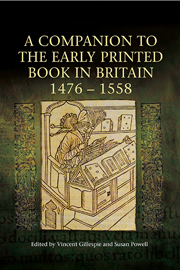Book contents
- Frontmatter
- Contents
- List of Illustrations
- List of Contributors
- Preface
- Acknowledgements
- Abbreviations
- Chronology of the Period
- Introduction
- I THE PRINTED BOOK TRADE
- II THE PRINTED BOOK AS ARTEFACT
- 4 Materials: Paper and Type
- 5 Bookbinding and Early Printing in England
- 6 Woodcuts and Decorative Techniques
- III PATRONS, PURCHASERS AND PRODUCTS
- IV THE CULTURAL CAPITAL OF PRINT
- Index of Manuscripts
- Index of Printed Books
- General Index
6 - Woodcuts and Decorative Techniques
from II - THE PRINTED BOOK AS ARTEFACT
Published online by Cambridge University Press: 05 April 2014
- Frontmatter
- Contents
- List of Illustrations
- List of Contributors
- Preface
- Acknowledgements
- Abbreviations
- Chronology of the Period
- Introduction
- I THE PRINTED BOOK TRADE
- II THE PRINTED BOOK AS ARTEFACT
- 4 Materials: Paper and Type
- 5 Bookbinding and Early Printing in England
- 6 Woodcuts and Decorative Techniques
- III PATRONS, PURCHASERS AND PRODUCTS
- IV THE CULTURAL CAPITAL OF PRINT
- Index of Manuscripts
- Index of Printed Books
- General Index
Summary
In his discussion of London, BL Additional, MS 36985, the ‘Founders’ Book' of Tewkesbury Abbey, which was purposely made in the late sixteenth century to look like a printed book and was ‘designed for a readership accustomed to the organization and appearance of printed books rather than manuscripts’, Julian Luxford concludes that ‘logic of organization and appearance made printed books more generally comprehensible than handwritten ones’. Contributing to their clarity of meaning were woodcuts, metal prints and even ornaments, decorations that accompanied printed images. While woodcuts functioned in some cases very like manuscript miniatures, and their purposes were as various, they also expanded visual vocabulary, introducing and labelling texts for a mass-market audience. Further, printing allows an emphasis on visual continuity, which can occur within one book or across collections of books, creating networks of meaning for fledgling readers. As I argue elsewhere, with print the development of visual literacy is connected with rising verbal literacy, while organisation of content is most particularly seen with the introduction of the title page. This survey considers briefly some changes that occurred in illustration from manuscript to print, sources for English woodcuts (mainly French), and the ways in which images were used to introduce and sometimes to link portions of texts or texts together in Sammelbände.
While every manuscript miniature is to some extent unique (even when copied from exemplars, sketches or model books), woodcuts were mechanically produced and were not usually in colour unless they had been painted by hand. A few editions printed by William Caxton are adorned with hand-decorated initials and borders.
- Type
- Chapter
- Information
- A Companion to the Early Printed Book in Britain, 1476-1558 , pp. 95 - 124Publisher: Boydell & BrewerPrint publication year: 2014



